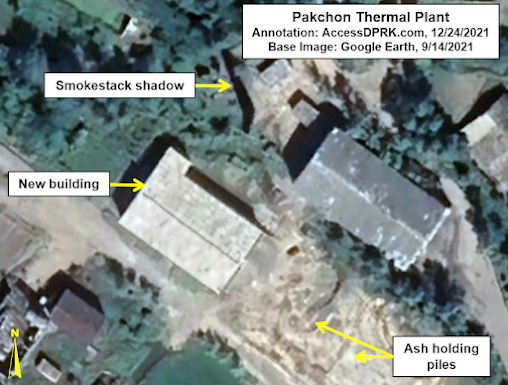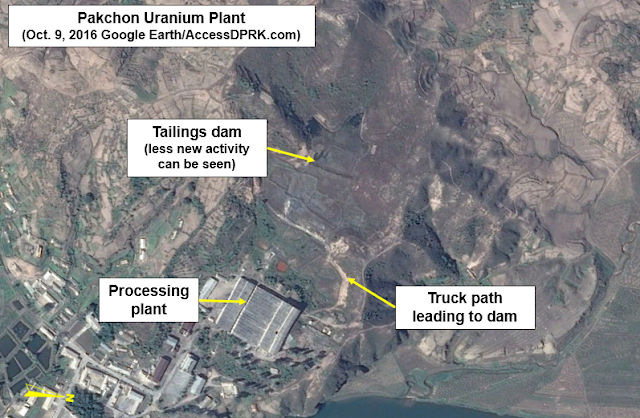The Pakchon Uranium Concentration Pilot Plant is North Korea's first uranium concentration plant. Converted from a graphite processing facility, Pakchon began to process uranium ore into "yellowcake" in 1982. Based on open-source information and satellite observations, it has likely been in caretaker status since 2002. But, as previously reported by AccessDPRK, low-level activities have continued at the plant.
According to the Center for Strategic and International Studies, such low-level activities may involve "small processing runs of iron-bearing ore of some type, caretaker maintenance work, or decommissioning of equipment within the plant."
However, recent satellite imagery suggests additional kinds of activity are now taking place.
A series of chemical or slurry tanks were constructed at the waste material reservoir between September 2021 and February 2024, along with small support structures and a new ~240 sq. meter holding or settling pond.
This opens up two main possible explanations for the activity. 1) that the waste material is being reprocessed to extract rare earth elements (REEs) or even residual uranium; 2) that the plant is actually undertaking an environmental remediation program to clean up the industrial waste.
Frank V. Pabian, former IAEA Nuclear Chief Inspector for Iraq, told AccessDPRK that it is most probable that they "are setting up to process the old waste tailings pile" in search of rare earth elements in a process that, considering North Korea's command economy, "does not have to be cost effective in the normal sense of things."
Rare earth elements such as gadolinium, neodymium, and yttrium can be used for a wide range of purposes, but they have become critical for modern military and electronic technologies. With international sanctions preventing North Korea from legally importing such material, the country needs to find domestic sources.
At Pakchon, as at Pyongsan, the uranium came from coal which was then processed to concentrate the uranium into yellowcake (a low-radiation powder of concentrated U-238, mostly in the form of triuranium octoxide) before it was shipped off to Yongbyon. The waste material was then deposited in a series of reservoirs.
Although it is unlikely that Pakchon has been engaged in uranium concentration activities since 2002, it seems that North Korea has found another use for the facility.
Tailings from uranium processing can contain concentrations of other valuable minerals like REEs, but their recovery still relies on expensive and complex chemical, physical, or electrical processes.
China is the world's leading supplier (90%) of processed REEs, creating a dangerous bottleneck that could be cut off in the event of economic or military confrontation. That risk to the world's supply has seen countries scramble for alternative sources.
Investing in technologies to make REE extraction economically viable from coal waste from power plants, other industrial sources, and even municipal waste is something multiple countries, including the United States, are engaged in. However, extracting the elements out of the waste requires a combination of physical and chemical processes.
As Pabian noted, North Korea isn't always bound by traditional economic considerations. Its drive for nuclear weapons has resulted in a crippled economy for decades and numerous sanctions, and so it has sought ways to evade and break sanctions by developing synthetic fuels from its own coal supplies to funding its activities through cryptocurrency theft.
Reprocessing material from Pakchon may be yet another attempt to get the raw materials the country needs for its weapons and technology projects. It's worth noting that regardless of whatever policy directives are specific to the activities at Pakchon, North Korea has been going back to tailings and gangue piles at mining sites around the country to reprocess that material as well.
Besides the new reprocessing site, other changes at Pakchon should also be noted.
As is shown, two of the plant's support buildings had their roofs replaced between 2021 and 2024. These follow similar changes in previous years to other buildings, and reenforces the assessment that Pakchon is still being used for various activities, just not large-scale uranium processing.
With the reprocessing of waste material in search of REEs or residual uranium, however, the use of these buildings as part of that reprocessing activity can't be ruled out.
As for the possibility that the activity is related to environmental remediation efforts, I do not think that it is likely. North Korea has repeatedly demonstrated its low regard for environmental and health safety, including by allowing industrial waste to flow into the Ryesong River and by polluting the Taedong River (Pyongyang's main water source). So, it would be a rare instance of remediation and the only instance known of such efforts at a nuclear facility, if that is what is taking place at Pakchon.
I believe that these developments at Pakchon, as well as the recently discovered construction activity at the suspected Kangson Uranium Enrichment Facility, should spur a review of all known nuclear facilities as well as key mining sites to see if there are other similar changes happening.
Regardless of if the developments at Pakchon are occurring in isolation or in tandem with other sites, it serves as a reminder that North Korea will use any and all sources of raw materials to further its technology programs and to earn foreign currency regardless of its international obligations.
I would like to thank my current Patreon supporters who help make all of this possible: Alex Kleinman, Amanda Oh, Donald Pierce, Dylan D, Joe Bishop-Henchman, Jonathan J, Joel Parish, John Pike, Kbechs87, Russ Johnson, and Squadfan.



























